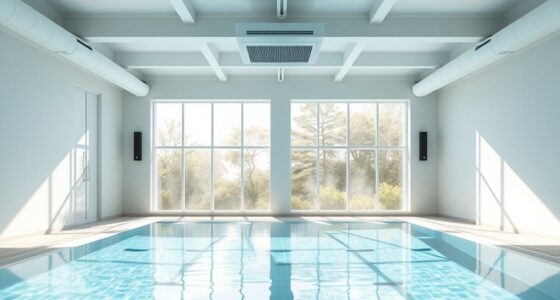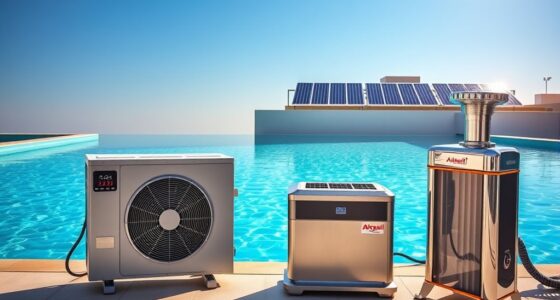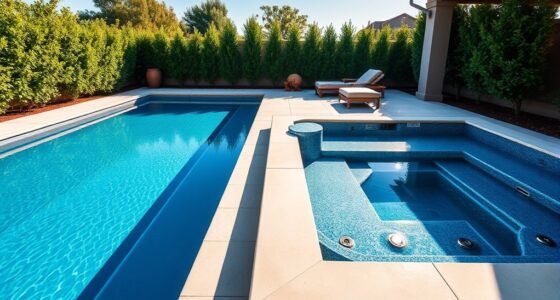Choosing between chlorine, salt, or UV for your Endless Pool depends on your lifestyle. Chlorine is affordable but requires regular testing and handling chemicals. Salt systems generate their own disinfectant, offering softer water with less maintenance but higher initial costs. UV sterilization is eco-friendly, reduces chemical use, and is low-maintenance, making it ideal for eco-conscious swimmers. Want to discover which option best fits your needs? Keep exploring to find the perfect water care solution for your pool.
Key Takeaways
- Chlorine provides continuous disinfection but requires ongoing chemical testing and handling, suitable for traditional pool maintenance.
- Salt systems generate chlorine naturally, reducing chemical purchases but involve higher initial costs and salt management.
- UV sterilization offers chemical-free water treatment, is eco-friendly, and requires minimal maintenance, ideal for low-chemical pools.
- Consider your budget, maintenance willingness, and eco preferences to choose the system that best fits your lifestyle.
- Regular water testing and routine maintenance are essential regardless of the chosen system to ensure clean, safe, and clear pool water.
How Chlorine Maintains Water Clarity and Safety
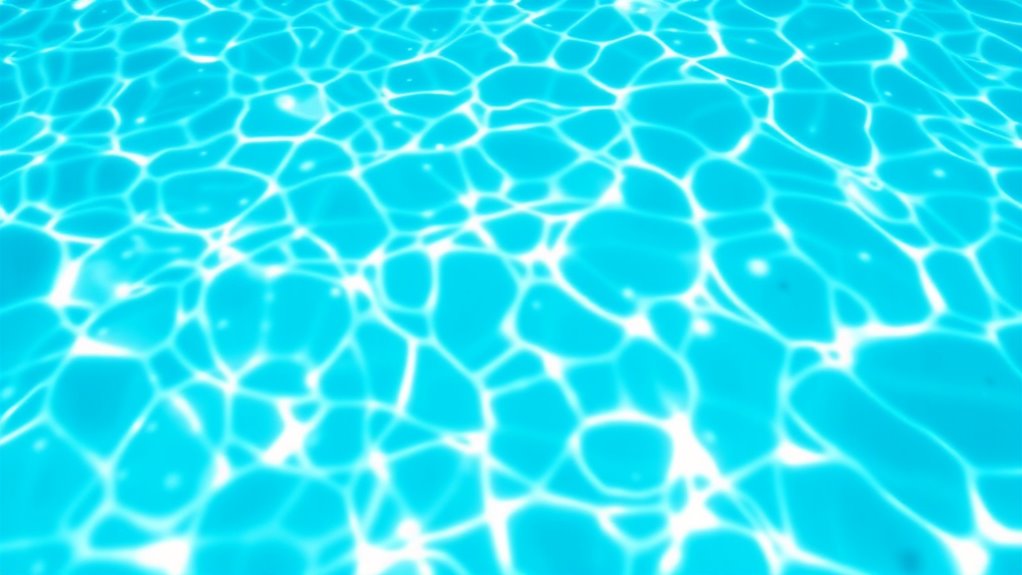
Chlorine is essential for keeping your pool water clear and safe because it actively kills bacteria, algae, and other harmful contaminants. When you add chlorine to your pool, it forms hypochlorous acid, which attacks and destroys germs, preventing infections and illnesses. It also helps control algae growth, keeping your water sparkling and free of green patches. Chlorine works quickly, especially when levels are properly maintained, providing a continuous disinfectant barrier. Regular testing and adjusting chlorine levels ensure your pool remains safe for swimming. Without enough chlorine, bacteria and algae can thrive, making the water cloudy and potentially hazardous. By maintaining proper chlorine levels, you create a healthy, inviting pool environment that’s both clean and safe for everyone to enjoy. Additionally, understanding the chemical reactions involved in chlorine disinfection can help optimize water treatment processes.
The Benefits and Drawbacks of Saltwater Systems

Saltwater systems offer an alternative way to keep your pool clean and comfortable, reducing the need for frequent chlorine additions. They generate chlorine naturally through salt electrolysis, which can result in softer, more skin-friendly water. However, salt systems can be costly to install and may require regular maintenance of the salt cell. Additionally, high salt levels might corrode pool equipment or surfaces over time. Understanding the ancient use of seeds like chia highlights the importance of sustainable and natural practices, which can also be reflected in choosing eco-friendly pool care options.
UV Sterilization: An Eco-Friendly Option
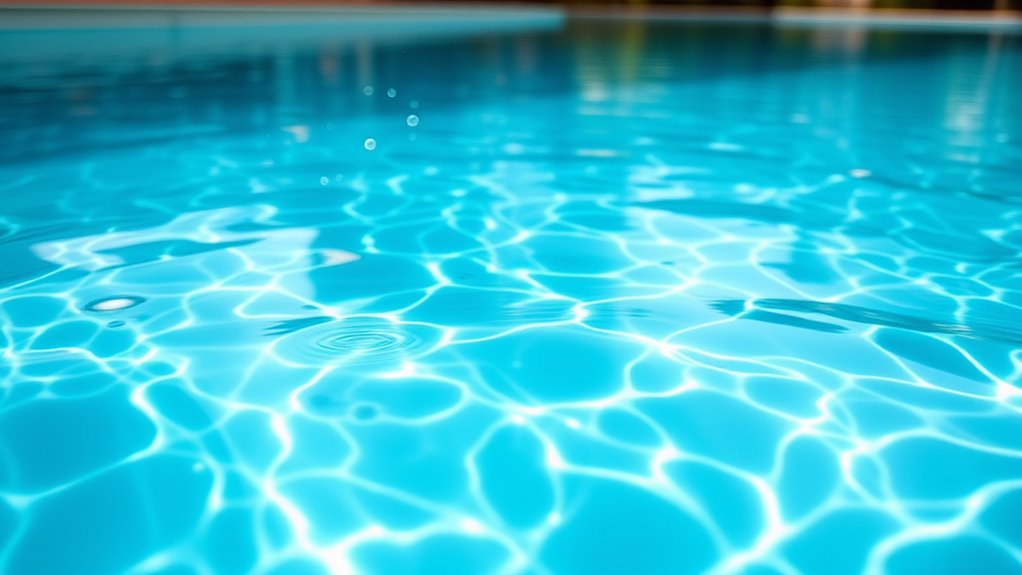
UV sterilization offers an eco-friendly way to keep your pool clean by using ultraviolet light to eliminate bacteria, viruses, and algae. This method doesn’t rely on chemicals, reducing the need for chlorine and other disinfectants that can harm the environment. When you install a UV system, water passes through a chamber where ultraviolet light destroys microorganisms on contact, providing immediate sterilization. It’s a fast, effective process that improves water clarity and safety without adding chemicals. UV sterilizers require minimal maintenance, mainly replacing the UV bulb periodically. Because it doesn’t produce chemical byproducts, it’s a healthier choice for swimmers and the environment alike. Additionally, understanding water treatment methods can help you choose the most suitable option for your pool’s needs. If you’re seeking a sustainable, chemical-free way to maintain your pool’s hygiene, UV sterilization is a smart, eco-conscious option.
Comparing Maintenance and Operating Costs

When comparing maintenance and operating costs for pool sterilization methods, it’s important to contemplate how each system impacts your budget over time. Chlorine pools require ongoing purchases of chemicals, regular testing, and equipment upkeep, which can add up monthly. Saltwater systems have higher initial setup costs but tend to lower ongoing chemical expenses, though you’ll need to replace salt cells periodically. UV sterilization involves a higher upfront investment in equipment, but it generally reduces chemical use and maintenance needs afterward. Over time, UV systems tend to be more cost-effective due to lower chemical and labor costs. However, keep in mind that evaluation frequency and energy consumption vary, influencing long-term expenses. Proper understanding of home theatre projectors can also contribute to a more efficient setup, ultimately saving you money. Carefully assessing these costs helps you choose the most economical solution for your needs.
Which System Is Right for Your Lifestyle and Pool Use
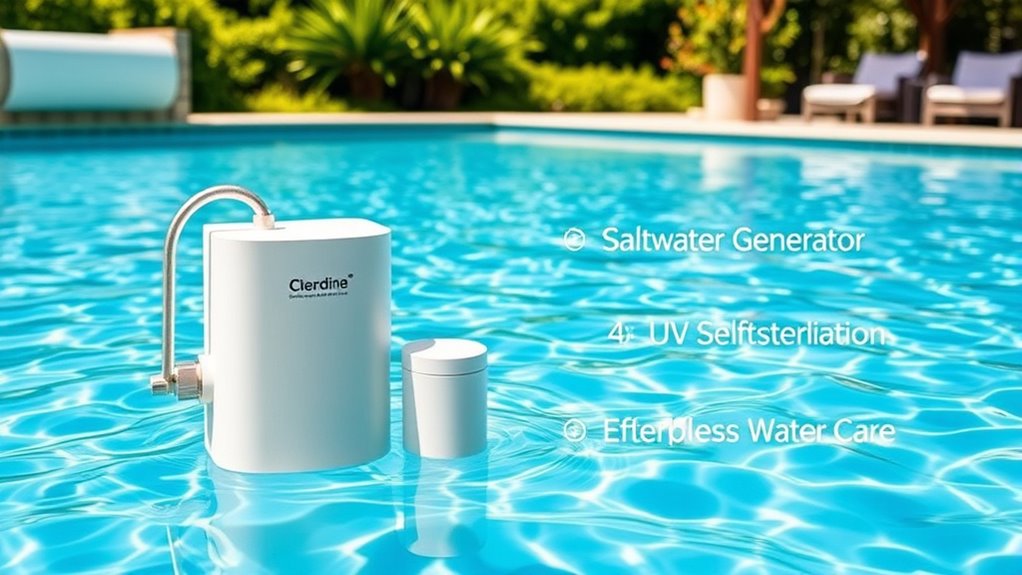
Choosing the right pool sterilization system depends heavily on your lifestyle and how often you use your pool. If you swim daily or host frequent gatherings, a salt or UV system might suit you by reducing chemical handling and offering quick water clarity. Conversely, if you prefer minimal maintenance or seasonal use, traditional chlorine could be more manageable. Consider these factors:
- Frequency of pool use
- Tolerance for chemical smell or irritation
- Willingness to perform regular maintenance
- Budget for setup and ongoing costs
- Desire for eco-friendly or low-chemical options
- Understanding of water treatment technologies can help you make an informed choice.
Matching your needs ensures you pick a system that simplifies water care, fits your routine, and keeps your pool inviting without hassle.
Tips for Seamless Water Care and Long-Term Pool Health

To keep your pool water clear and healthy, regular testing is essential. Maintaining a consistent chemical balance and sticking to a proper maintenance routine will save you time and prevent issues down the line. These simple steps make long-term pool care much easier and more effective. Incorporating proper water treatment techniques similar to Nissan tuning principles can ensure your pool maintains optimal performance and longevity.
Regular Water Testing
Ever wonder how to keep your pool water crystal clear and balanced? Regular water testing is key. It helps you catch issues early, so you don’t end up with cloudy or unsafe water. Testing your water weekly ensures proper chemical levels and prevents algae growth. Use test strips or a liquid kit for quick results, and always follow the instructions. Keep an eye on essentials like pH, sanitizer levels, alkalinity, calcium hardness, and stabilizer. When levels are off, it’s easier to adjust before problems escalate. Consistent testing saves time and money, keeps your pool inviting, and extends equipment life. Remember, staying on top of water quality today means less hassle tomorrow. Make testing part of your routine to enjoy a pristine, worry-free pool season. Incorporating water testing into your maintenance routine can also help you identify when to consider additional filtration or sanitation options for optimal water quality.
Consistent Chemical Balance
Maintaining consistent chemical balance is essential for seamless water care and long-term pool health. When your pH, alkalinity, and sanitizer levels stay stable, your water remains clear and safe, reducing the risk of algae growth and corrosion. Regular testing helps you catch fluctuations early, so you can adjust chemicals promptly. Avoid large swings in levels by adding small amounts of chemicals gradually. Use automatic feeders or timers to help maintain steady dosing, especially if your pool is in frequent use. Consistency prevents strain on your filtration system and minimizes the need for costly repairs. Keep a routine schedule for testing and adjusting chemicals, and always follow manufacturer instructions. Staying vigilant ensures your pool stays inviting, balanced, and low-maintenance over time.
Proper Maintenance Routine
Establishing a consistent maintenance routine is key to ensuring your pool stays clean and healthy over the long term. Regular upkeep prevents algae growth, maintains water clarity, and extends your equipment’s lifespan. To keep things simple, set a weekly schedule that includes testing and adjusting chemicals, skimming debris, brushing the walls, vacuuming the floor, and checking equipment functionality.
- Test water pH and sanitizer levels
- Clean skimmer and pump baskets
- Brush walls and tiles
- Vacuum the pool floor
- Inspect and maintain filters and pumps
Sticking to these tasks helps you catch issues early and keeps your pool in top shape. With routine care, you’ll enjoy clear, balanced water with less effort and fewer surprises.
Frequently Asked Questions
How Often Should I Test My Pool Water’s Chemical Levels?
You should test your pool water’s chemical levels at least twice a week to keep everything balanced. Regular testing helps you catch issues early, ensuring safe, clear water. If you notice heavy use or after storms, test more frequently. Use a reliable test kit or strips, and adjust chemicals as needed. Consistent testing keeps your pool inviting, safe, and easy to maintain.
Can I Combine Different Water Care Systems Safely?
Mixing water care systems is like blending different colors; it can create a beautiful hue or muddy the waters. If you want to combine systems, consult your manufacturer first to guarantee compatibility. Some systems work well together, like salt and UV, while others might conflict. Always follow the recommended guidelines to keep your pool safe and clear, preventing chemical reactions that can cause cloudiness or damage.
What Are the Signs of System Failure or Inefficiency?
You’ll notice system failure or inefficiency if your water becomes cloudy, develops a strong odor, or shows increased algae growth. You might also see your sanitizer levels drop unexpectedly or experience skin irritation after swimming. If your pool’s sanitizer isn’t maintaining proper levels or the water chemistry seems off despite adjustments, it’s a sign your system isn’t working effectively. Regular testing helps catch these issues early before they worsen.
How Does Climate Affect Pool Water Treatment Choices?
You might think climate doesn’t impact pool treatment, but it actually plays a big role. Hot, sunny weather speeds up evaporation and algae growth, so you’ll need more frequent or stronger sanitation methods. Cooler or shady climates slow down these processes, reducing chemical needs. By adjusting your treatment based on your climate, you guarantee your pool stays clean and balanced without overusing chemicals, saving both time and money.
Are There Health Concerns With Long-Term Chemical Use?
Long-term chemical use can raise health concerns, especially if you’re exposed frequently or sensitive to certain substances. You might notice skin, eye, or respiratory irritation, and some chemicals could pose risks over time. To minimize these issues, consider regular testing and balancing of your pool water, and explore alternative treatments like salt or UV systems. Staying informed and cautious helps keep your swimming safe and enjoyable.
Conclusion
Choosing the right water care system can feel like finding the perfect rhythm for your pool’s health. Whether you lean toward the familiar glow of chlorine, the gentle touch of salt, or the eco-friendly whisper of UV, each option softly shapes your pool experience. With a little understanding and routine care, you’ll keep your pool sparkling and inviting, creating a serene oasis that’s effortless to maintain. After all, a well-cared-for pool is your personal haven of refreshment.


